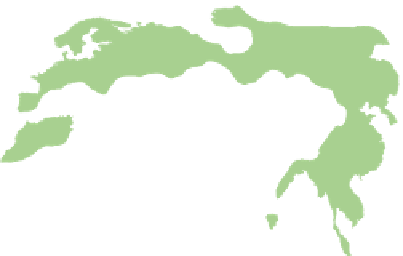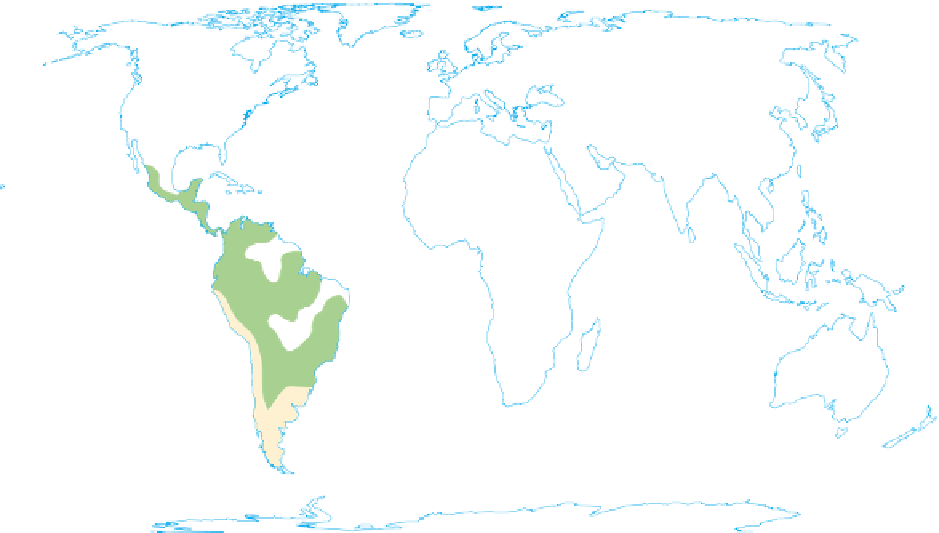Geoscience Reference
In-Depth Information
60
°
N
60
°
N
30
°
N
30
°
N
Tropic of Cancer
AT L A N T I C
O C E A N
PA C I F I C
O C E A N
PA C I F I C
O C E A N
Equator
0
°
0
°
I N D I A N
O C E A N
Tropic of Capricorn
30
°
S
30
°
S
Forest Regions
60
°
S
60
°
S
150
°
W
120
°
W
90
°
W
60
°
W
30
°
W
0
°
30
°
E
60
°
E
90
°
E
120
°
E
150
°
E
Figure 10.27 The extent of forest regions on Earth.
Forests have adapted to every zone of latitude on Earth except for the polar
regions.
human footprint on biomes around the world. Values range
from 0 (least influenced) to 100 (most impacted). As you
can clearly see, eastern China, India, Europe, and the eastern
United States have extensive human footprints in biomes.
The portions of Earth that remain relatively untouched by
humans are usually remote, extreme places like the Sahara
Desert in North Africa, northern Russia into Siberia, and
northern Canada. This part of the discussion focuses on
some of the ways that people have impacted vegetation on
Earth. It is not meant to be comprehensive, but will provide
a sense of how humans have modified the natural vegetation
in biomes around the world.
ics (Figure 10.27). Overall, this extent of coverage amounts to
about one-third of Earth's total landmass, excluding Antarctica
and Greenland.
Ongoing monitoring indicates that the extent of global
forest cover has decreased extensively in the past 20 years due
to human activities. This kind of land cover change can eas-
ily be detected with satellite remote sensing, as can be seen in
Figure 10.28. High amounts of loss have occurred even though
forest is actually expanding in some areas due to natural pro-
cesses or through
afforestation
, which is the planting of trees
by people in previously nonforested areas. As you can see in
Table 10.2, Europe and Asia had net increases in forest cover
between 1990 and 2010. The pattern in Asia is particularly in-
teresting, as the net gain this century reverses a trend of over-
all forest loss in the 1990s. These gains are largely the result
of aggressive planting of trees in China, which have offset
high amounts of deforestation in places such as Borneo and
Indonesia. In North America, the rate of forest loss appears to
have stabilized in the past 20 years.
Although some modest increases in forest cover have
occurred recently in some areas, the average annual rate of global
deforestation between 2000 and 2010 was about 13 million hect-
ares (32 million acres). At a continental scale, this high rate of
deforestation is clearly most associated with Africa and South
America. Over the course of the past 20 years, Africa has lost
about 12% of its forest, whereas about 5% of the forest has been
cut in South America (Table 10.2), with about 60% to 70% of
this deforestation related to cattle ranches. Another reason that
tropical rainforests are cut is by subsistence farmers who practice
slash
and
burn agriculture
. This technique first involves cutting
Deforestation
Perhaps the most obvious way that people impact vegetation
is through
deforestation
, which is the process where large
tracts of forest are cleared by humans, either for commercial
use or to make way for agriculture. A good place to begin
the discussion of deforestation is to examine the current ex-
tent of forest cover around the world. According to the United
Nations
Global Forest Resources Assessment
, approximately
3.9 billion hectares (9.6 billion acres) of Earth were covered
by forest in 2010. Of this total, 47% was in the tropics, 33%
was in the boreal forest, 11% in the middle latitudes and tem-
perate areas like the Pacific Northwest, and 9% in the subtrop-
Deforestation
The removal of trees for economic or agricul-
tural purposes.



























































































